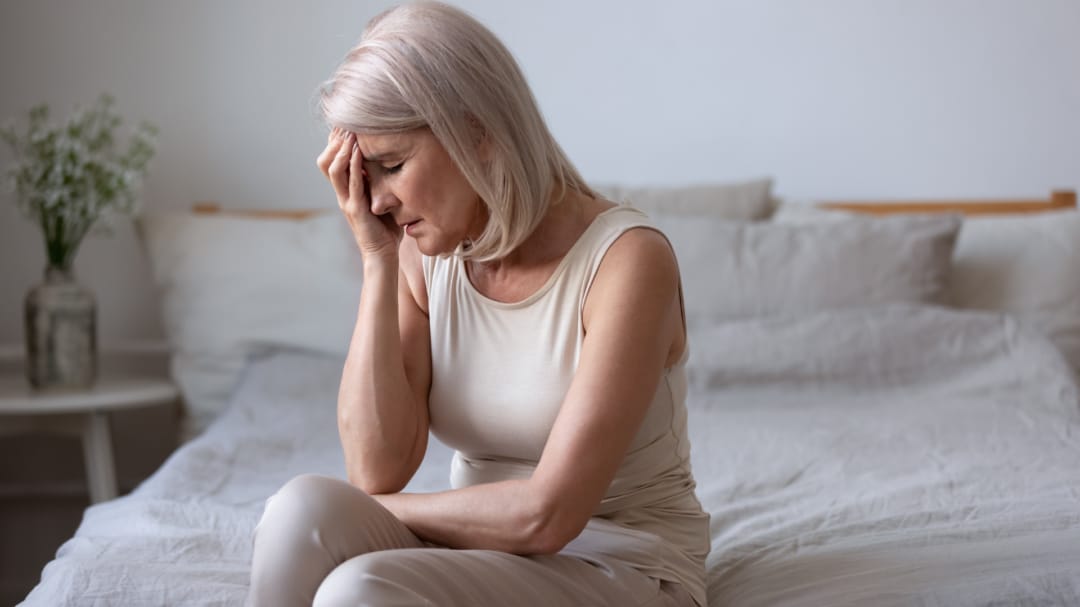Managing Menopause-Related Urinary Incontinence

Pure Sports Medicine
- 30 October, 2023
- Menopause
- Women's Health
- 6 min read
“I didn’t know there was anything that could be done.” “I thought I was on my own.” “You’re the first person who’s taken the time and listened.”

These are all phrases I hear regularly when working with people going through menopause, or “the change”, as it’s frequently referred to. As a pelvic health physio, I specialise in helping people manage the symptoms of women’s health conditions, such as menopause, so that they can continue to live healthy, active lives, free of pain or embarrassment.
That starts with sharing important information that all women should have access to, even in advance of this stage of life, so that you know what your options are, and you don’t have to suffer in silence. Because the one thing you can be sure of is that you are certainly not alone in this.
So, let’s dive into it and break the stigma surrounding menopause and urinary incontinence.
What is Stress Urinary Incontinence (SUI)?
Urinary incontinence is the umbrella term for any involuntary leaking of urine.
Within this umbrella term stress urinary incontinence is defined by the International Continence Society (ICS) as the ‘involuntary loss of urine on effort or physical exertion’, for example sporting activities, sneezing, intercourse – really any activity that can increases intra-abdominal pressure.
It can happen at any age and affects millions of individuals in the UK.
Challenges & Risk Factors for Menopausal People
The menopause is a multi-systemic transition which women and people assigned female at birth experience, usually around the age of 50 (although can be brought on by cancer treatment, hysterectomy and oophorectomy procedures where the womb and ovaries are removed, and gender affirming surgery or treatment (1,2)) which affects multiple bodily systems, including the genitourinary system.
Those going through the menopause often face unique challenges and risk factors for stress urinary incontinence because during the menopause your oestrogen levels reduce, and this can exacerbate the likelihood of developing this symptom.
The main risk factors for urinary incontinence are:
- constipation
- connective tissue disorders
- reduced fitness resulting in reduced muscle bulk
- childbirth
- a persistent cough
- surgery
- being overweight (3-6)
Although it is important to know the risk factors, it is also important to note that the list above does not immediately mean you will develop this symptom. It does however equip you with more knowledge so you know what to look out for, and when you may need to speak to a healthcare professional to discuss your options to manage this symptom.
As I’ve said before, you are not alone in what you’re going through. There are many women who have experienced urinary incontinence during the menopausal process, and we are here to help you manage this so you can continue to live the active life you deserve.
What happens to the Pelvic Floor Muscles?
The pelvic floor is a group of muscles and connective tissues that form a supportive hammock-like structure at the base of the pelvis.
Its function is to support and stabilise organs in the pelvic area, including the bladder, uterus, and rectum.
Additionally, the pelvic floor muscles play a crucial role in controlling bowel and bladder movements, maintaining continence, and facilitating sexual function by aiding in arousal and orgasm.
Like with any other muscle they can be weak, tight or have poor coordination which can lead to developing symptoms such as urinary incontinence. (7)
How to Treat Stress Urinary Incontinence
At Pure Sports Medicine, we have gold standard research to back up pelvic floor exercising for stress urinary incontinence.
As a first line of treatment the National Institute for Health and Care Excellence (NICE) recommends three months of Pelvic floor training because it found it to be ‘just as effective as surgery for around half of women with stress urinary incontinence and has no negative side effects.’ (8)
That said, over 20% of women do not do their pelvic floor exercises with the correct technique. Sometimes loosing valuable rehabilitation time or worsening their condition by continuing to use their pelvic floor in the ways they have been doing, or even increasing the demand on these muscles and how much weight is being passed through them during any chosen activity.
I appreciate how difficult it is to know if you’re training your pelvic floor correctly or incorrectly, because, simply, you can’t see it! There is a new product by Junofem called the femfit which is a small device, with eight sensors, that sits inside the vagina and connects to an app on your phone or tablet. You can then see the live data as you move, showing whether you are tensing (or not) the muscles as needed.
Although this is incredible progress in the world of women’s health, it is difficult to then know what to do with that information even if you have access to, or the option to purchase, a femfit device.
Either way, the best way to check if you are doing your exercises correctly is by seeing a pelvic health physiotherapist so you can have your pelvic floor muscles assessed by a specialist, Ideally one who is recognised by the Pelvic Obstetric, and Gynaecological Physiotherapy society (POGP).
Along with being able to assess your pelvic health, a specialist pelvic health physiotherapist will be able to provide personalised advice and tailored exercises – so you know the movements you’re doing are working your pelvic floor correctly and how it’s supposed to feel – and strategies to manage stress urinary incontinence effectively.
We are also able to refer you on for any additional, relevant treatment or investigations should you require.
Does Stress Urinary Incontinence affect People’s Mental Health?
Urinary incontinence during menopause can have a significant impact on a person’s mental health for a couple of reasons.
Firstly, the hormonal shifts and changes in the pelvic floor muscles that accompany menopause often contribute to urinary incontinence.
Secondly, women experiencing urinary incontinence may grapple with feelings of embarrassment, shame, and a blow to their self-esteem.
The loss of bladder control can disrupt daily routines, limit social activities, and create a sense of isolation.
Anxiety about potential leakage and fear of public embarrassment may lead to avoidance behaviours, further diminishing their quality of life.
The constant worry and concern about leaks can result in heightened stress levels, affecting overall mental well-being.
In all cases, it is important to discuss all your symptoms, no matter how small, with a healthcare professional as we are here to support you and help you navigate this process.
Why is it important to seek help from a healthcare provider during the menopause?
Although the menopause is a normal bodily change and urinary incontinence is common, my mission is to spread the word that you do not need to “get on with it”, be silent, or just wear a pad because that is what you’ve been told before.
Seeking support, education about management strategies, and open communication with healthcare professionals can help alleviate the mental burden associated with urinary incontinence during this life stage and ultimately treat the underlying cause of this pelvic health symptom.
Empowering Women to Prioritise Their Health
Managing stress urinary incontinence during menopause requires a multifaceted approach that incorporates your past and present social, medical and psychological history to implement an evidence-based information treatment plan. The support of a healthcare professional can help guide and support you through this process, advising the best path to take and course of treatment for you.
By prioritising your pelvic floor health and implementing appropriate strategies, you can enhance your quality of life and regain control over stress urinary incontinence.
Although urinary incontinence is incredibly common – 1 in 3 women in the UK will have it in their lifetime – with the support of a pelvic health specialist, the evidence shows us that the majority of women regain their continence, confidence, and control. (9)
The menopause is a very normal process that happens to people assigned female at birth as they age and, although it can happen earlier (often caused by procedures such as a hysterectomy and oophorectomy, which are the removal of the womb / uterus and ovaries), most commonly begins around 50 years of age. (10-13)
The stigma attached to it, and the symptoms that can come with it, are slowly being dismantled by the growing body of research in this field, supporting evidence-based treatments, and an increasing openness to speak and talk about it in the media and in general. Both offering hope and dispelling unnecessary fears.
Developing menopausal symptoms should not feel like the end of the world for the people who go through it because there are highly experienced and dedicated clinicians, specialised in treating conditions such as stress urinary incontinence, and we are here and keen to help you.
References
- https://www.tandfonline.com/doi/full/10.1080/13697137.2023.2176217
- https://www.menopause.org.au/health-info/fact-sheets/early-menopause-chemotherapy-and-radiation-therapy
- https://thepogp.co.uk/_userfil…
- https://link.springer.com/article/10.1007/s00192-013-2065-3
- https://pubmed.ncbi.nlm.nih.gov/15453888/
- https://www.ncbi.nlm.nih.gov/pmc/articles/PMC5538935/
- https://www.ncbi.nlm.nih.gov/p…
- https://www.nice.org.uk/guidance/ng123/chapter/Rationale-and-impact#pelvic-floor-muscle-training-3
- https://pubmed.ncbi.nlm.nih.gov/9560071/
- https://www.menopause.org.au/health-info/fact-sheets/early-menopause-chemotherapy-and-radiation-therapy
- https://www.tandfonline.com/doi/full/10.1080/13697137.2023.2176217
- https://www.ncbi.nlm.nih.gov/pmc/articles/PMC8189332/
- https://www.rcog.org.uk/for-the-public/menopause-and-later-life/hysterectomy/

Advice
Over the last 20+ years our experts have helped more than 100,000 patients, but we don’t stop there. We also like to share our knowledge and insight to help people lead healthier lives, and here you will find our extensive library of advice on a variety of topics to help you do the same.
OUR ADVICE HUBS See all Advice Hubs

